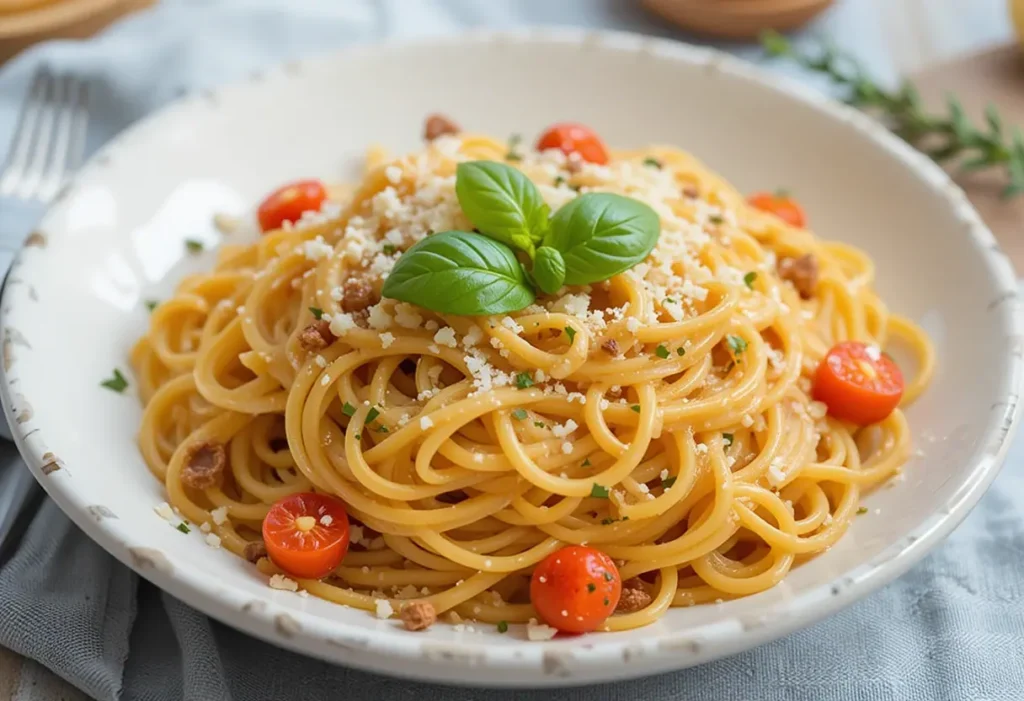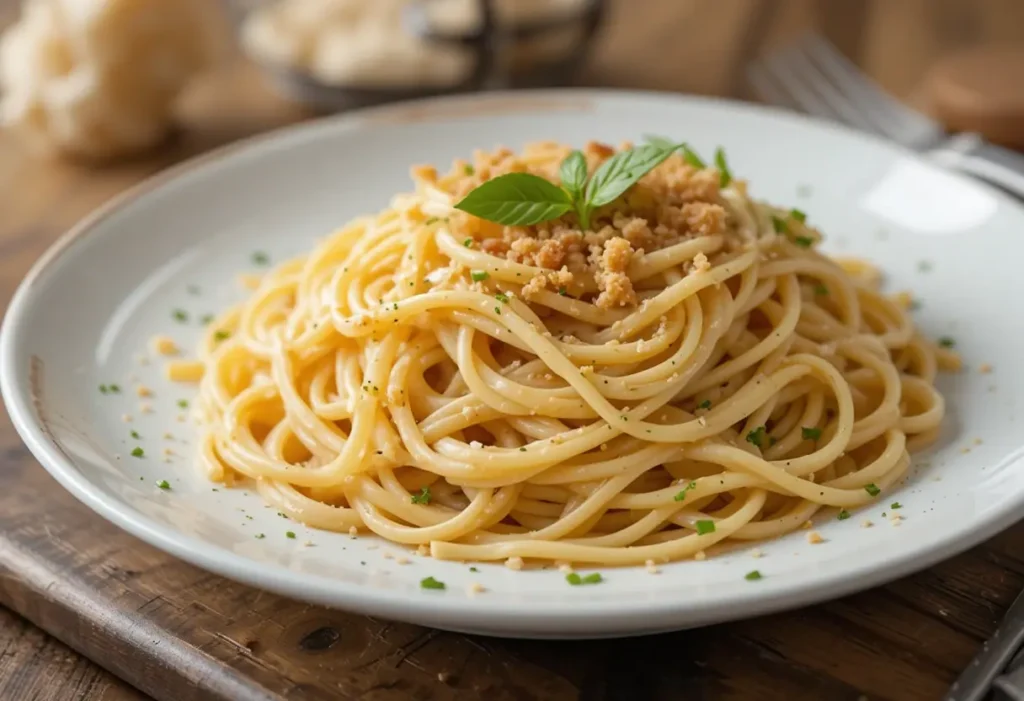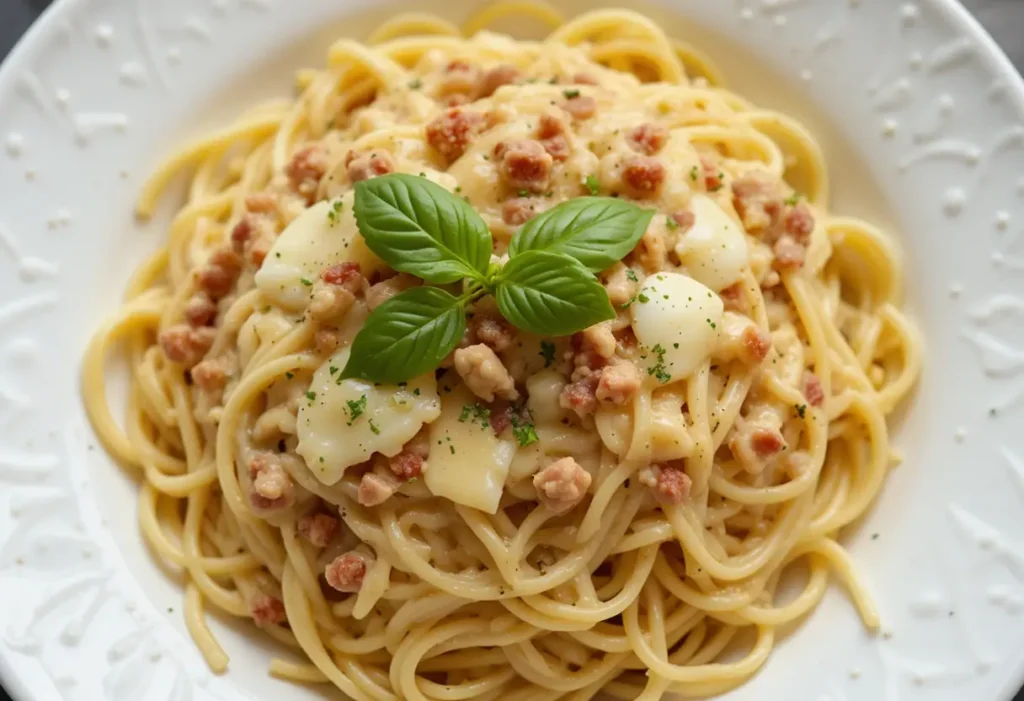Spaghetti Carbonara is a legendary Italian pasta dish celebrated for its simplicity and bold flavor. Rooted in Roman culinary traditions, it combines just a handful of high-quality ingredients to create a creamy, savory masterpiece. If you want to master this recipe, it’s essential to understand the components and techniques that make it shine.
To begin your journey into the world of Carbonara, check out this Creamy Spaghetti Carbonara guide for a step-by-step approach and expert tips.
The Core Ingredients of Spaghetti Carbonara
To create an authentic Spaghetti Carbonara, you need only a few carefully selected ingredients. Each plays a crucial role in balancing the dish’s flavors.
1. Spaghetti
- Spaghetti is the traditional base for this dish because of its shape, which holds the creamy sauce perfectly.
- However, other long pasta such as bucatini or linguine can be great substitutes if spaghetti is unavailable.
2. Guanciale
- Guanciale, a cured pork jowl, is one of the most important ingredients. Its rich, fatty flavor adds depth to the sauce, making it essential for an authentic taste.
- If guanciale isn’t accessible, pancetta or bacon can work as substitutes, though the flavor will differ slightly. Learn more about guanciale and pancetta and decide which suits your recipe best.
3. Eggs
- The eggs in Carbonara are what create the dish’s luxurious creamy sauce. Using a mix of whole eggs and yolks ensures the ideal balance of creaminess and richness.
- To achieve the best result, whisk the eggs with grated cheese before adding them to the hot pasta.
4. Pecorino Romano Cheese
- Pecorino Romano, a sharp and salty sheep’s milk cheese, is traditional in this recipe.
- Although Parmesan can replace Pecorino in a pinch, it results in a milder and less authentic flavor. Discover the nuances of using different cheeses in this guide to creamy sauces.
5. Black Pepper
- Freshly cracked black pepper is crucial for adding warmth and spice, which balances the dish’s richness.

Optional Ingredients and Modern Variations
Although the classic recipe is beloved, modern adaptations can suit different tastes and dietary needs. Here are a few options:
Parmesan Cheese
- Parmesan is often blended with Pecorino Romano for a subtler cheese flavor.
Cream
- While cream is not part of traditional Carbonara, some modern recipes add it for an extra layer of richness.
Garlic or Onion
- Adding garlic or onion provides additional depth, but these are not typical in authentic recipes.
Vegetarian Alternatives
- For a vegetarian variation, you can replace guanciale with sautéed mushrooms or roasted vegetables. This version maintains the creaminess while offering a unique flavor profile.
To explore other creative pasta dishes, take a look at this recipe for Buffalo Chicken Pasta.
Perfecting the Technique
While the ingredients are straightforward, the technique for preparing Spaghetti Carbonara requires careful attention.
Tips for a Perfect Carbonara Sauce
- Toss the pasta with the egg and cheese mixture off the heat. This prevents the eggs from scrambling and ensures a smooth, creamy sauce.
- Always use freshly grated Pecorino Romano or Parmesan. Pre-grated cheese can clump and affect the sauce’s texture.
Common Mistakes to Avoid
- Overheating the sauce can lead to scrambled eggs, ruining the dish’s creamy consistency.
- Using poor-quality cheese diminishes the depth of flavor. Always choose high-quality ingredients.
If you’re curious about other pasta combinations, consider this helpful article: Does Pasta and Chicken Go Together?.

Frequently Asked Questions
What is the origin of Spaghetti Carbonara?
This dish hails from Rome and became widely popular during World War II due to its simplicity and the availability of ingredients.
Can cream be used in Carbonara?
Although cream is sometimes included in modern recipes, traditional Carbonara achieves its creamy texture using only eggs and cheese.
What’s the difference between guanciale and pancetta?
Guanciale, made from pork jowl, offers a richer flavor than pancetta, which comes from pork belly and is leaner.
Why does Carbonara sometimes taste too salty?
The saltiness typically comes from Pecorino Romano and guanciale. To avoid this, use these ingredients sparingly and balance them with unsalted pasta water.
Internal Linking Opportunities
- Include a rich anchor text like “Creamy Spaghetti Carbonara” linked to Creamy Spaghetti Carbonara for readers seeking more detailed instructions.
- Reference “Buffalo Chicken Pasta” with a link to Buffalo Chicken Pasta to showcase another creative pasta recipe.
- Suggest “Does Pasta and Chicken Go Together?” linked to Does Pasta and Chicken Go Together? for pairing ideas.
Spaghetti Carbonara shows how simple ingredients—when used correctly—can create extraordinary results. With high-quality guanciale, Pecorino Romano, and fresh eggs, you can bring a touch of Rome to your kitchen. For more inspiration, explore these guides and unlock the full potential of your cooking skills.


1 thought on “What Are the Ingredients of Spaghetti Carbonara?”
Comments are closed.